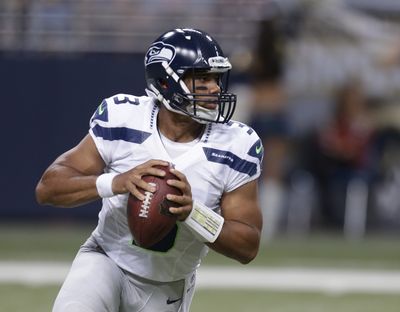Seahawks fail on third-down conversions

SEATTLE – The training wheels have to come off. Or the handcuffs need to be loosened or the leash lengthened.
A variety of metaphors has been invoked to call for giving rookie quarterback Russell Wilson more latitude to pilot a passing game that ranks dead last in the NFL.
Just one problem with that analysis: It’s based on an inaccurate diagnosis of the primary problem for the Seahawks. Seattle did not complete a pass longer than 17 yards last Sunday in St. Louis, but that’s not the reason the Seahawks lost.
They lost because they converted only two of nine third-down plays.
Scrutinizing third-down execution is not nearly as exciting as calling for coach Pete Carroll to let Wilson show off that big arm. It’s much easier to get indignant about the play-calling, and say that Seattle isn’t scoring because the coaches are too timid to let the rookie rock and fire.
Yes, the play-calling is conservative, but that isn’t the only reason Seattle has scored 27 points the past eight quarters. Seattle has not converted a third down by pass in either of those games. That’s right, not one. Its four third-down conversions the past two weeks all came on runs, and in that time, Wilson is 1 for 10 passing on third down for 3 yards, has been sacked twice and intercepted once. He has rushed for two first downs in that situation.
Those are the kind of statistics you’d expect from a team consistently condemned to third-and-forever, but that’s not the case. Seattle has the league’s leading rusher, Marshawn Lynch, and it has consistently made headway on first and second down.
In St. Louis, the Seahawks needed 5 yards or fewer on seven of nine third downs it faced. In Week 3 against Green Bay, they needed 5 yards or fewer on five of 10 third-down plays.
“First and second down has been very effective for us,” Carroll said. “We have not had a lot of third-and-longs.”
This is what offensive coordinators mean when they talk about staying on schedule, gaining ground on the first two downs, so the third one is manageable, and so far Seattle has done that.
“Those are workable numbers,” Carroll said.
The problem is that it’s still not working. Drives that should be extended aren’t, and that fact is much more troubling than the fact the Seahawks rank last in the league in passing yardage.
That’s a statistic that can be misleading because teams tend to rack up passing yards when they’re playing catch-up. Carroll has made no secret of his desire for a deliberate ground game, and that approach puts a premium on quarterbacks who not only protect the ball, but convert those short third-down plays to extend drives.
Anyone who’s criticizing Seattle for the lack of outside receiving threats or the reluctance to air it out is advised to take another look at those third-down numbers.
Seattle’s drives have bogged down not because of lack of big plays, but the inability to execute small ones.